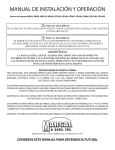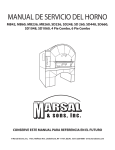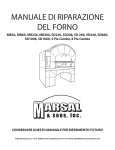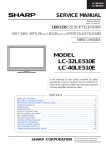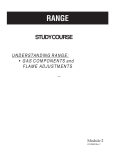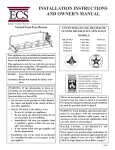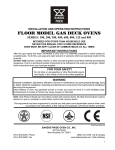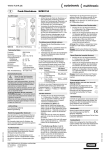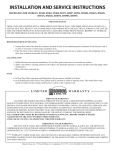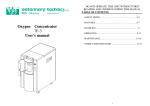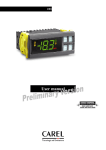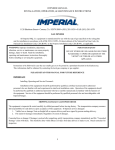Download INSTALLATION & OPERATING MANUAL
Transcript
INSTALLATION & OPERATING MANUAL Deck Ovens: MB42, MB60, SD236, SD248, SD 260, SD448, SD660, SD1048, SD1060 FOR YOUR SAFETY DO NOT STORE OR USE GASOLINE OR OTHER FLAMMABLE VAPORS AND LIQUIDS IN THE VICINITY OF THIS OR ANY APPLIANCE. FOR YOUR SAFETY POST INSTRUCTIONS TO BE FOLLOWED IN THE EVENT THE USER SMELLS GAS IN A PROMINENT LOCATION. THIS INFORMATION SHALL BE OBTAINED BY CONSULTING YOUR LOCAL GAS SUPPLIER. WARNING IMPROPER INSTALLATION, ADJUSTMENT, ALTERATION, SERVICE OR MAINTENANCE CAN CAUSE PROPERTY DAMAGE, INJURY, OR DEATH. READ THE INSTALLATION, OPERATING, AND MAINTENANCE INSTRUCTIONS BEFORE INSTALLING OR SERVICING THIS EQUIPMENT. ELECTRICAL GROUNDING INSTRUCTIONS THIS APPLIANCE, WHEN INSTALLED, MUST BE ELECTRICALLY GROUNDED IN ACCORDANCE WITH LOCAL CODES, OR IN THE ABSENCE OF LOCAL CODES, WITH THE NATIONAL ELECTRICAL CODE, ANSI/NFPA 70, OR THE CANADIAN ELECTRICAL CODE, CSA C22.2 AS APPLICABLE. THIS APPLIANCE IS EQUIPPED WITH A THREE PRONG (GROUNDING) PLUG FOR YOUR PROTECTION AGAINST SHOCK HAZARD AND SHOULD BE PLUGGED DIRECTLY INTO A PROPERLY GROUNDED THREE-PRONG RECEPTACLE. DO NOT CUT OR REMOVE THE GROUNDING PRONG FROM THIS PLUG. KEEP THE OVEN AREA FREE AND CLEAR FROM COMBUSTIBLE AND NONCOMBUSTIBLE CONSTRUCTION. DO NOT OBSTRUCT THE FLOW OF COMBUSTION AND VENTILATION AIR. THIS OVEN HAS ZERO CLEARANCE ON BOTH SIDES BUT A 3” - 4” SPACE MUST BE LEFT AT THE REAR TO ALLOW ADEQUATE CLEARANCE FOR AIR OPENINGS INTO THE COMBUSTION CHAMBER INSURING PROPER CIRCULATION OF AIR INTO THE BURNER SYSTEM. AN ELECTRICAL DIAGRAM IS LOCATED ON THE INSIDE OF THE CONTROL DOOR ON ALL MB SERIES OVENS. Marsal & Sons, Inc. 175 East Hoffman Ave., Lindenhurst, NY 11757 THIS MANUAL MUST BE RETAINED FOR FUTURE REFERENCE. INSTALLATION & OPERATING MANUAL TABLE OF CONTENTS I. INSTALLATION MANUAL SERVICE ACCESS ELECTRICAL CONNECTION GAS CONNECTION GAS AND ELECTRICAL SPECIFICATIONS DELIVERY OVEN LOCATION ADJUSTMENTS ASSOCIATED WITH INITIAL INSTALLATION ASSEMBLY INSTRUCTIONS VENTILATION - CANOPY METHOD VENTILATION - DIRECT CONNECTION METHOD VENTILATION PROBLEMS INSTALLATION OF BAKING CHAMBER BRICKS CURING THE OVEN DECK 1 1 1 2 3 3 3 4 5 5 7 7 9 II. OPERATING MANUAL STARTING THE OVEN OVEN CONTROL MAINTENANCE CLEANING THE OVEN 10 10 11 11 INSTALLATION MANUAL Installation must conform with local codes, or in the absence of local codes, with the National Fuel Gas Code, ANSI Z223.1, Natural Gas Installation Codes, CAN/CGA-B149.1, or the Propane Installation Code, CAN/CGA-B149.2, as applicable. 1. The appliance and its individual shutoff valve must be disconnected from the gas supply piping system at test pressures in excess of ½ psig (3.45kPa). 2. The appliance must be isolated from the gas supply piping system by closing its individual manual shut-off valve during any pressure testing of the supply system at test pressures in excess of ½ psig (3.45kPa). SERVICE ACCESS All service can be done through the Control Door opening and the Burner Door opening. An access panel is located on the left side of the oven for more access to the controls. If this is blocked off all service will be done from the front of the oven. ELECTRICAL CONNECTION A 15 AMP service must be provided for each oven. For 115 Volt usage, a cord and plug is provided but connection to the electrical service must comply with local codes; or in the absence of local codes, with the National Electrical Code, ANSI/NFPA No. 70 (or latest edition) GAS CONNECTION A ¾” NPT inlet is located at the rear of the oven. Undersized gas supply lines will restrict gas supply and affect oven performance. If other appliances are supplied by the same supply line the supply line must be sized to carry the combined volume without causing more than ½” pressure drop at the manifold of each appliance on the line at full rate. NOTE: During installation, there will be air in the line. The air must be bled off before ignition can be established. GAS PIPING A properly sized gas supply system is essential for maximum oven performance. Piping should be seized to provide a supply of gas sufficient to meet the maximum demand of all appliances on the line without loss of pressure at the equipment. Additional Gas Connection Instructions 1 2 GAS HOSE RESTRAINT If the oven is mounted on casters, a commercial flexible connector with a minimum of 3/4” (1.9 cm) inside diamter must be used along with a quick connect device. The restraint, supplied with the Flexible Hose Kit, must be used to limit the movement of the unit so that no strain is placed upon the flexible connector. With the restraint fully stretched the connector should be easy to install and quick connect. 1. Mount the supplied bracket to the hold located on the rear or base frame on the same side as the gas supply. The connector must comply with the Standard Connectors for Movable Gas Appliances, ANSI Z21.59 or Connectors For Moveable Gas Appliances CAN/CHA-6.16 and a quick disconnect device that complies with the Standard for Quick Disconnect Devices for Use With Gas Fuel, ANSI Z.41 or Quick Disconnect For Use With Gas Fuel CAN 1-6.9. Adequate means must be provided to limit the movement of the appliance without depending on the connection and the quick disconnect device or its associated piping. Adequate means must be provided to limit the movement of the appliance qithout depending on the connection and the quick disconnect device or its associated piping. GAS AND ELECTRICAL SPECIFICATIONS Models MB42, SD448, SD1048 MB60, SD660, SD1060 SD236 SD248 SD260 Input Rate NATURAL GAS 95,000 130,000 50,000 65,000 80,000 PROPANE GAS 90,000 120,000 50,000 65,000 80,000 Manifold Pressure NATURAL GAS 4.5 IN. WC 4.5 IN. WC 4.5 IN. WC 4.5 IN. WC 4.5 IN. WC PROPANE GAS 11 IN. WC 11 IN. WC 11 IN. WC 11 IN. WC 11 IN. WC Electrical Requirements (MB Models Only) Volts 120VAC Frequency 60Hz 0.9 AMPS Phase 1 DELIVERY Marsal & Sons, Inc. cannot assume responsibility for loss or damage suffered in transit. The carrier assumed full responsibility for delivery in good order when the shipment was accepted. We are, however, prepared to assist you if filing a claim is necessary. OVEN LOCATION The oven should be installed in a location in which the facilities for ventilation permit satisfactory combustion of gas and proper venting. The oven should be located so as not to interfere with proper circulation of air within the confined space. In buildings where normal infiltration does not provide the necessary air, outside air should be introduced. It is essential that an adequate air supply to the oven be maintained to provide a sufficient flow of combustion and ventilation air. • Place the oven in an area that is free of drafts. • Do not place the oven on a curb base or seal to a wall. This will restrict the flow of air and prevent proper ventilation. Pilot outages or yellow, floating flames on the main burners are indicative of a lack of secondary air. Before making any utility connections to this oven, check the rating plate to be sure the oven specifications are compatible with the gas and electrical services supplied for the oven. The rating plate is located on the inside of the control door. ADJUSTMENTS ASSOCIATED WITH INITIAL INSTALLATION Each oven, and its component parts, have been thoroughly tested and inspected prior to shipment. However, it is often necessary to further test or adjust the oven as part of a normal and proper installation. These adjustments are the responsibility of the installer, or dealer. Since these adjustements are not considered defects in material or workmanship, they are not convered by the Original Equipment Warranty. They include, but are not limited to: • • • • • • calibration of the thermostat adjustment of the doors burner adjustments leveling testing of gas pressure tightening of fasteners No installation should be considered complete without proper inspection, and if necessary, adjustment by qualified installation or service personnel. 3 ASSEMBLY INSTRUCTIONS For all oven models: 1. Place the oven base in the final location. 2. 3. Level the base from left to right and front to back by adjusting the legs in each corner. Place the oven body on top of the oven base making sure that the front and the front corners are even between the base and the body. 4. Install the two 1/4 x 20 x 1” bolts through the front of the base into the front of the body from underneath the base. Next, align the back corners of the body and the base together and install the other two 1/4 x 20 x 1” bolts through the back of the base and the back of the body. 5. For stackable units, place the top oven on the bottom oven and align their front and sides. The weight of the unit will keep it in place. 6. Connect a gas line to the back of each oven and follow all local gas codes in connecting to the gas supply. 7. 8. Plug in the electric plug for the light to an electric power supply. (For MB Ovens Only) Connect the exhaust system to the flue of the oven. NOTE: FOLLOW ALL LOCAL FIRE AND SAFETY CODES FOR VENTING AN OVEN. IF THE OVEN IS BEING INSTALLED UNDER A CANOPY HOOD, THE 6” X 14” STAINLESS STEEL FLUE VENT MUST BE INSTALLED. A CANOPY IS RECOMMENDED EVEN WHEN DIRECT VENTED. 9. The base should be sealed to the floor using a NSF approved sealant. 4 VENTILATION Local codes and conditions vary greatly from one area to another and must be complied with. The following are the minimum requirements for good ventilation. Please remember that these are general recommendations or guidelines and you may have a special condition or problem that will require the services of a ventilation engineer or specialist. Proper ventilation is the oven owner’s responsibility. Improper ventilation will inhibit oven performance, such as the pilot going out or the burning of the bottom of pies. Marsal & Sons, Inc. cannot assume responsibility for loss or damage suffered as a result of improper installation. WARNING: Failure to properly vent the oven can be hazardous to the health of the operator and may result in operational problems, unsatisfactory baking and possible damage to the equipment. Damage sustained as a direct result of improper ventilation will not be covered by the Manufacturer’s warranty. CANOPY METHOD The ideal method of venting a gas oven is through the use of a properly designed ventilation hood which extends 10” - 12” in front of the oven. The short stainless steel flue that is supplied with the oven must be installed. Place the flue over the collar that is located on the top of the oven and press down until it is firmly locked in place. The angle should face forward and always away from any filters. A strong exhaust fan will create a vacuum in the room. For an exhaust system to work properly, replacement air must be introduced into the room. The hood should be sized to completely cover the equipment plus an overhang of at least 6” (15 cm) on all sides not adjacent to a wall. The distance from the floor to the lower edge of the hood should not exceed 7’ (2.1 m). The capacity of the hood should be sized appropriately with provisions for an adequate supply of make up air. DIRECT CONNECTION METHOD An unrestricted vent pipe that provides exit air at the oven of a minimum of 55 CFM per oven must be provided for the vent pipe at the top of the oven. The vent pipe should be a minimum of 6” in diameter. A draft diverter (or draft hood) must be installed for a direct vent connection system in order to work properly. No more than two 90° elbows should ever be used in a direct vent connection. 5 6 DIRECT CONNECTION METHOD (continued) WARNING: It is essential that the direct flue be installed as follows. Incorrect installation will result in unsatisfactory baking and oven damage. The flue must be class B or better. The height of the flue should rise 6-8 ft (2-2.5 m) above the roof of the building or any proximate structure. The flue should be capped with a UL Listed type vent cap to isolate the unit from external environmental conditions. The direct vent cannot replace air consumed and vented by the oven. Provisions must be made to supply the room with sufficient make-up air. Total make-up air requirements for each oven section should be approximately 30 CFM per section. To increase the supply air entering the room, a ventilation expert should be consulted. INSTALLING THE DRAFT HOOD Ovens ordered for direct venting are supplied with a draft hood. Install the draft hood as follows: 1. Place the draft hood over the flue connector. 2. Install the rest of the venting system to the draft hood (draft diverter). DIRECT CONNECTION METHOD CANOPY METHOD INSULATED FLUE VENT 6” Flue STAINLESS STEEL VENT (INCLUDED) DRAFT DIVERTER VENT (INCLUDED) VENTING PROBLEMS If the venting of any deck oven is either restricted or forced in any way the baking characteristics of the oven will be adversely affected. Examples of restricted venting include: • use of tees and elbows • long horizontal runs Insufficient make-up air can cause heated air and combustibles to remain in the oven shortening the life of the components. INSTRUCTIONS FOR INSTALLING BRICKS The following instructions are model specific. 1. Start by installing the brick used for the baking deck. These bricks are 2” Thick and must be installed ROUGH SIDE UP. Push bricks together to eliminate any space. MB 42 Place the (3) 12” x 36” bricks and the (1) 6” x 36” brick on the sheet metal of the oven deck. The 6” x 36” brick must be placed on the right side of the deck oven as shown below. 12” 12” 12” 6” FRONT OF OVEN MB 60 SD 660 SD 1060 Place the (5) 12” x 36” bricks on the sheet metal of the oven deck as shown below. 12” 12” 12” FRONT OF OVEN 12” 12” 7 INSTRUCTIONS FOR INSTALLING BRICKS (continued) SD 448 SD1048 Place the (4) 12” x 36” bricks on the sheet metal of the oven deck as shown below. 12” 12” 12” 12” FRONT OF OVEN SD 236 Place the (3) 12” x 24” bricks on the sheet metal of the oven deck as shown below. 12” 12” 12” FRONT OF OVEN SD 248 Place the (4) 12” x 24” bricks on the sheet metal of the oven deck as shown below. 12” 12” 12” 12” FRONT OF OVEN SD 260 Place the (5) 12” x 24” bricks on the sheet metal of the oven deck as shown below. 12” 12” 12” FRONT OF OVEN 12” 12” 8 INSTRUCTIONS FOR INSTALLING BRICKS (continued) MB SERIES OVENS ONLY. 2. Install the brick in the dome. These bricks are 1 ½” thick and must be installed SMOOTH SIDE FACING DOWN. MB 42 1. Slide (5) 9 ½” x 6” bricks on each of the 10” brick support tracks in side the top of the oven. 2. Slide (5) 12” x 6” bricks on each of the 12 ½” tracks. MB 60 1. Slide (5) 12” x 6” bricks on each of the brick support tracks. 5 Bricks On Each Track CURING THE OVEN DECK 1. 2. Sweep off all the debris from the brick deck surface. Cure the oven deck slowly by preheating the stones with the pilot burner on for 1 hour. Then gradually increase the temperature 100° F per hour from 300° - 600° F is reached. NOTE: WHEN LIGHTING THE OVEN FOR THE FIRST TIME, AS THE TEMPERATURE INCREASES, SMOKE WILL OCCUR FROM THE OVEN. BE SURE TO LEAVE THE DOORS CLOSED, VENT OPEN, AND TO HAVE THE EXHAUST FAN ON THE HOOD TURNED TO ON. © Marsal & Sons, Inc. 175 E. Hoffman Ave. Lindenhurst, NY 11757 (631) 226-6688 www.marsalsons.com 9 OPERATING MANUAL 10 STARTING THE OVEN 1. 2. 3. 4. 5. 6. Purge all air out of the gas line. Open the control door and open the burner door at the bottom of the oven. Hold the red button in and manually light the pilot (this is seen through the opening on the left, inside the burner area). Hold the red button in until the probe on the left side of the pilot begins to glow red. (approximately 30 seconds) Then release the red button. Adjust the oven temperature to the desired amount (usually between 500°-550° F for pizza). The main burners will turn on. Close the control and burner doors. NOTE: The oven’s cooking surface is for pizza and bread only. All other products must be placed in pans. • Set the bypass on the thermostat by following the instructions in the service manual. • Check calibration and adjust if necessary by following service manual. Setting the bypass and calibrations and other adjustments are not covered under warranty and are the responsibility of the owner or the dealer who sold or installed the appliance. If the oven is supplied on casters and is connected to the supply piping by means of a connector for movable appliances, be aware that a restraint must be on the appliance and, if disconnection of the restraint is necessary, you must reconnect this restraint after the appliance has been returned to its originally installed position. OVEN CONTROL PREHEATING OVEN On initial startup, preheat the oven to 600° F (315° C) over a period of four hours in increments of 100° F (55° C) starting at 300° F (149° C). TURNING OVEN OFF You can shut the main burners off and leave the pilot on by turning the green valve, located between the safety pilot valve and the thermostat, clockwise to the 3 o’clock position. Extinguish the pilot flame by blowing out the pilot flame. A 5 minute complete shutoff period is necessary before the oven can be relighted. OVEN EXTERIOR MAINTENANCE 11 The stainless steel surface should be cleaned when cool using a mild soap and warm water solution on a sponge or a clean cloth. OVEN INTERIOR The inside metal surfaces should be cleaned with a mild detergent and a damp cloth when necessary. The brick surface should be brushed clean and then a wet cloth draped over the brush should be run over the surface while the oven is still hot. NOTE: The burner venturi must be checked and kept clean. The area around the air shutter must stay about 1/8” - 3/16” open and free of any dust. CLEANING THE OVEN On the stainless steel front the deposits of baked splatter may be removed with any nontoxic industrial stainless steel cleaner. Heat tint and heavy discoloration may be removed with any non-toxic commercial oven cleaner. 1. Apply cleaners when the oven is cold, and always rub with the grain of the metal. Clean the aluminized interior portion of the oven with a mild detergent. DO NOT use caustic solutions such as ammonia, lye or soda ash. DO NOT use domestic oven cleaners. Any of these products will damage the aluminum coating. DAILY CLEANING • Clean brick surfaces using a deck scraper and brush. A wet towel draped over the brush should be run over the brick surface while the baking chamber is still hot. WEEKLY CLEANING • Brush out the combustion compartment behind the burner door. 6 MONTH CLEANING • Clean secondary air ducts and air entry ports. • Clean the area around the air shutter so that it stays 1/8” - 3/16” open and free of dust. CAUTION: Disconnect the power supply on MB Ovens before Cleaning or Servicing. If maintenance or repairs are required, contact the factory, the factory representative or a local Marsal service company. © Marsal & Sons, Inc. 175 E. Hoffman Ave. Lindenhurst, NY 11757 (631) 226-6688 www.marsalsons.com













